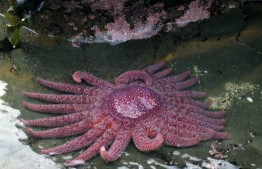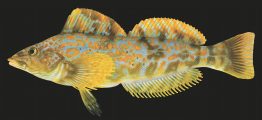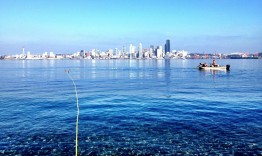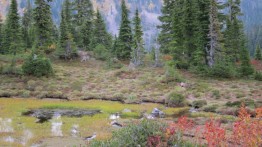Climate change is perhaps felt most acutely in the Arctic right now, but by the start of the next century, animal species in the Amazon basin region will be harder hit as the Earth warms. In a study published this week in the journal PLOS ONE, researchers have used new high-performance computing methods and comprehensive data on the distribution of thousands of species to map the threat that climate change poses to birds, mammals and amphibians across the Western Hemisphere.
Read more at UW Today »Student collaboration leads to first results describing sick sea star immune response
Though millions of sea stars along the West Coast have perished in the past several years from an apparent wasting disease, scientists still don’t know why. The iconic marine creature develops white lesions on its limbs and within days can dissolve or “melt” into a gooey mass. Last year, researchers identified a type of pathogen known as a densovirus as the likely cause, but they still can’t explain the mass die-off three years ago or why a common ocean virus can wreak havoc on so many starfish species from Alaska to Southern California.
Read more at UW Today »Known fish species living in the Salish Sea increases in new report
Coho salmon, Pacific halibut and even the dogfish shark are familiar faces to many people in the Salish Sea region. But what about the Pacific viperfish, northern flashlightfish, dwarf wrymouth or the longsnout prickleback? A new report co-authored by Ted Pietsch at The School of Aquatic and Fishery Sciences documents all fish that live in the Salish Sea, a roughly 6,500-square-mile region that encompasses Puget Sound, the Strait of Juan de Fuca, the Strait of Georgia, the San Juan Islands and the Canadian Gulf Islands.
Read more at UW Today »Young chum salmon may get biggest nutrition boost from Elliott Bay restored beaches
In the midst of ferry boats, container ships and tourists crowding Seattle’s Elliott Bay, young salmon are just trying to get a decent meal. The fish hatch in the rivers and streams that feed into Puget Sound and almost immediately rely on eating small organisms near the shore, including in the heart of Seattle’s commerce-filled waterfront. Though salmon share the busy Elliott Bay waters with boats and barges, scientists suspect built-up, “armored” shorelines and large piers may be the main culprits disrupting fish habitat.
Read more at UW Today »Climate change could leave Pacific Northwest amphibians high and dry
Far above the wildfires raging in Washington’s forests, a less noticeable consequence of this dry year is taking place in mountain ponds. The minimal snowpack and long summer drought that have left the Pacific Northwest lowlands parched have also affected the region’s amphibians through loss of mountain pond habitat. According to a new paper published Sept. 2 in the open-access journal PLOS ONE, this summer’s severe conditions may be the new normal within just a few decades.
Read more at UW Today »





